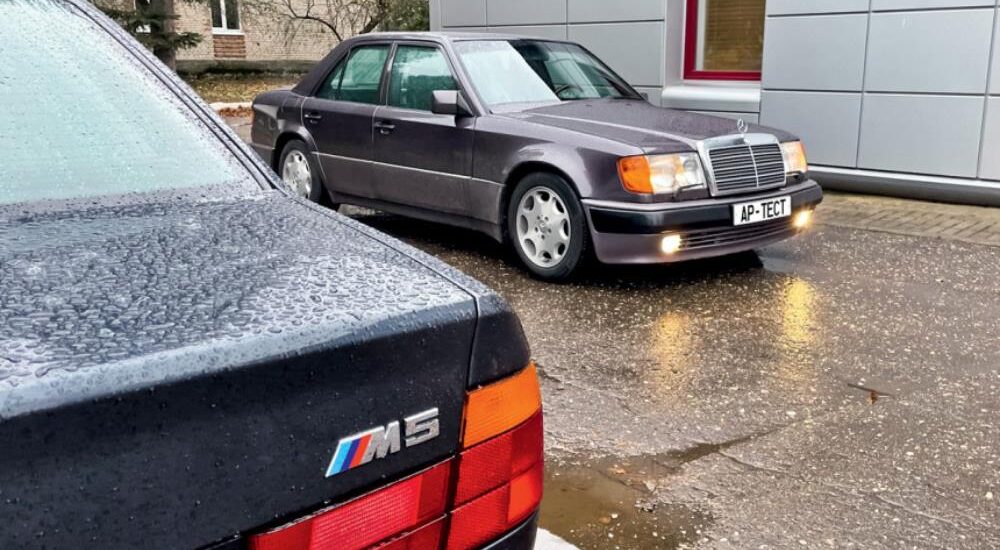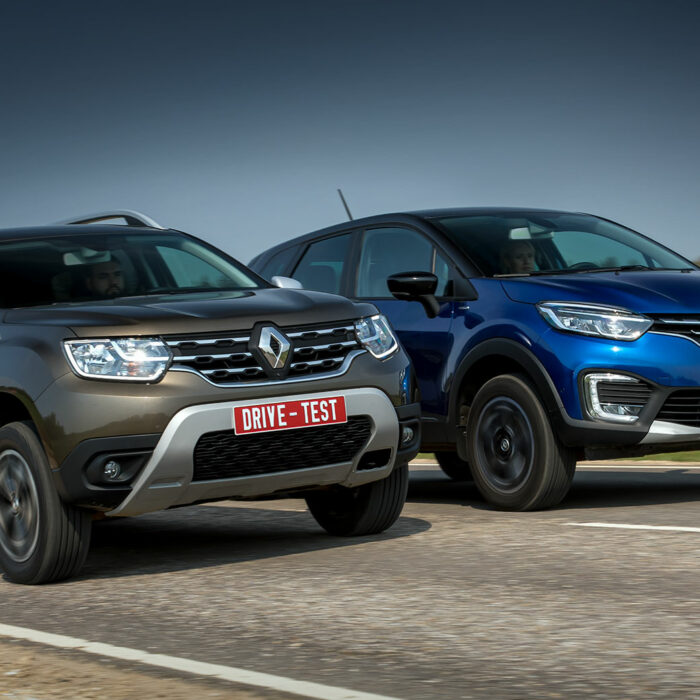Quando Mercedes annunciò la W124, BMW rispose con la E34. La risposta di Monaco fu forte e chiara con l’annuncio della M5, e Stoccarda fu pronta a rispondere con la 500 E. È interessante notare che, nonostante le forti differenze tra queste super berline, esse condividono un punto di partenza particolare: entrambe hanno iniziato il loro viaggio in una carrozzeria di camion.

Il progetto della W124 è iniziato nel 1977, con il disegno iniziale realizzato da Peter Pfeiffer e Josef Gallitzendörfer, ed è stato finalizzato dal responsabile del centro stile, Bruno Sacco.
Il tono della rivalità è stato innegabilmente impostato dalla BMW negli anni ’80, spinta dall’ambizione di superare la Mercedes. La concorrenza era così agguerrita che Monaco dovette raddoppiare gli sforzi solo per mantenere l’inseguimento. Per ottenere un vantaggio, serviva una svolta, che arrivò con il lancio della E32 “Seven” nel 1986, seguita dalla BMW 750i con motore V12 un anno dopo. La sfida era quindi quella di replicare questo successo con la “Five”.
Lanciata nel 1988, la berlina E34 è stata creata con un unico obiettivo: surclassare la formidabile W124. Quattro anni dopo il suo debutto, la Mercedes era ancora una meraviglia dell’ingegneria automobilistica. Durante il nostro retro test, mi sono addentrato nel BMW Praxis, un catalogo per concessionari utilizzato per formare gli addetti alle vendite sulla nuova “Cinque”. Questo manuale di 240 pagine è un tesoro di dettagli sulla E34, pieno di approfondimenti che raramente si trovano altrove.
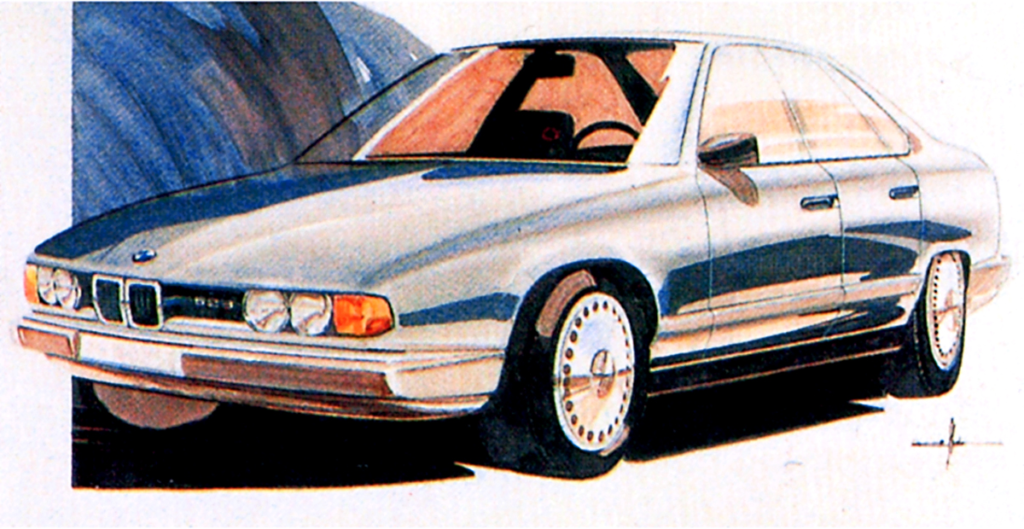
I geni italiani della E34 sono stati abbozzati nel 1982 da Ercole Spada. Il lavoro sul “Five” è stato continuato da Jay Mays e completato sotto la guida di Klaus Luthe.
Dalle strategie di marketing alle innovazioni tecniche, la rivalità era intensa. BMW analizzò le quote di mercato delle varie professioni, notando una preferenza per la “Propeller” tra i manager di medio livello e la “Star” tra i dirigenti di alto livello e i liberi professionisti. BMW ha anche pubblicizzato i miglioramenti nell’aerodinamica, dichiarando di aver ottenuto un miglioramento del 18% rispetto al modello precedente e un coefficiente di resistenza aerodinamica pari a 0,30, il tutto mantenendo l’iconico design della griglia. Sottintendendo che i risultati avrebbero potuto essere ancora migliori se non fosse stato per la loro politica di pneumatici standard, la BMW ha fatto una battuta alla Mercedes, i cui migliori dati aerodinamici sono stati ottenuti con pneumatici più stretti.

L’equilibrio tra funzionalità (asse verticale) ed estetica (asse orizzontale) come percepito da BMW. È emerso che Lancia è la meno pratica, mentre Audi è considerata la meno bella.
Innovazioni come l’esclusivo sistema di tergicristalli della Mercedes, in grado di pulire l’86% del parabrezza, sono state accolte dai tergicristalli estesi della BMW, che hanno eguagliato l’area di pulizia ma hanno aggiunto un meccanismo per migliorare le prestazioni delle lame alle basse velocità. Allo stesso modo, mentre la Mercedes vantava il riscaldamento automatico degli specchietti e delle bocchette, la BMW introdusse un meccanismo di chiusura riscaldato che si attivava tenendo premuta la maniglia della portiera, una caratteristica di ingegnosa progettazione.

È evidente come le aziende abbiano lavorato in modo diverso con il front-end. Per Mercedes, i gruppi ottici e la griglia fungono da strumento aerodinamico che contribuisce a ridurre la portanza. Per BMW, i fari sono soprattutto il volto del marchio. Tuttavia, il catalogo BMW Praxis fornisce cifre interessanti: per vincere la resistenza dell’aria a una velocità di 180 km/h, la E34 ha bisogno di 64 CV, e a 200 km/h di 87 CV. Il 20% in meno rispetto al suo predecessore, la E28, con un simile muso di squalo.
Ogni modello ha introdotto caratteristiche progettate per superare l’altro. Le famose sospensioni posteriori a cinque bracci della Mercedes si sono scontrate con i miglioramenti apportati dalla BMW all’assetto esistente della E34, tra cui gli ammortizzatori a controllo elettronico e il sistema di sterzo Servotronic. BMW ha anche risposto all’ASR di Mercedes con il suo sistema avanzato ASC+MSR, che non si limita alla trazione, ma si occupa anche del bloccaggio delle ruote in fase di decelerazione.
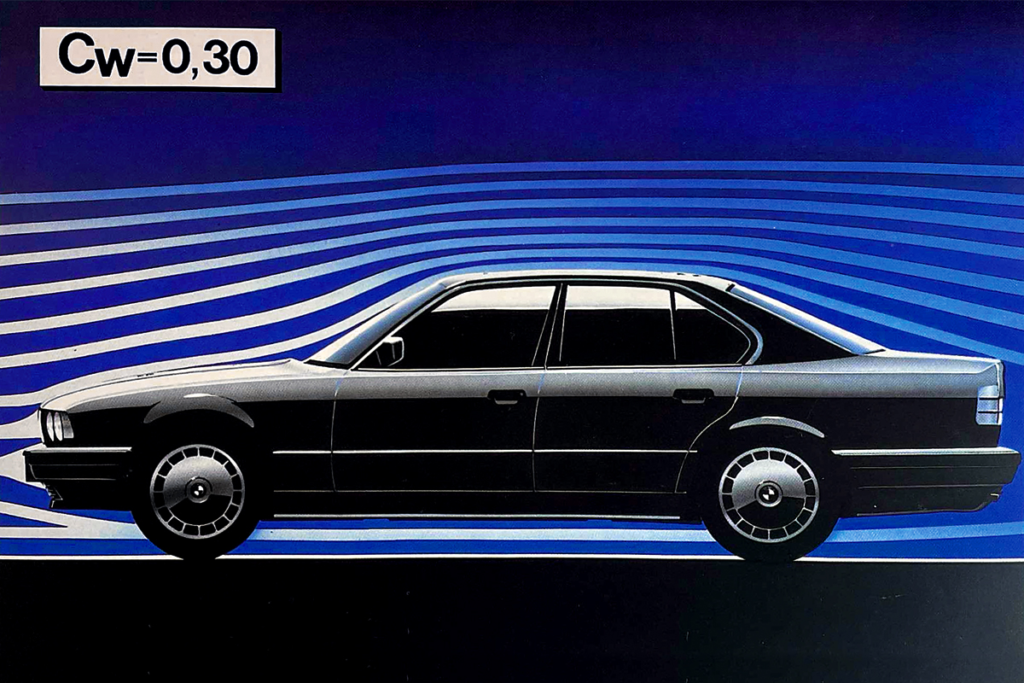
Il catalogo fornisce persino una motivazione per le caratteristiche di maneggevolezza della M5, suggerendo che BMW ha intenzionalmente messo a punto il telaio per ottenere un sottosterzo da neutro a leggero, che può passare al sovrasterzo con l’acceleratore, presumibilmente per contrastare la natura di “tail-happy” della Mercedes.
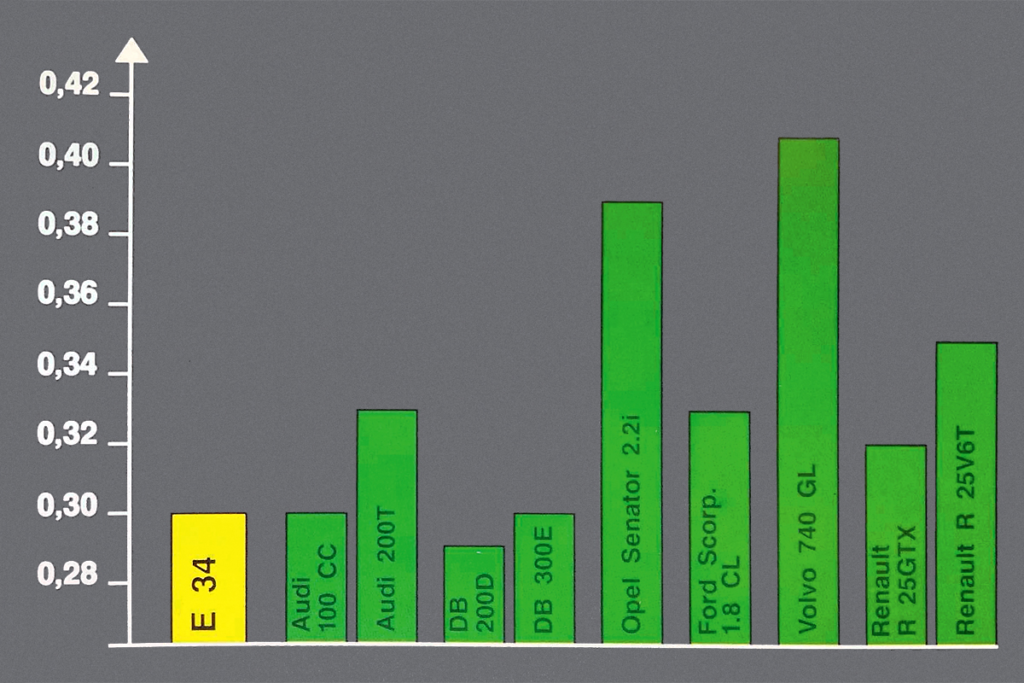
L’aerodinamica dei classici e dei contemporanei. Per mettersi al passo con Mercedes, BMW ha prelevato dipendenti da Audi.
Questa battaglia continua non solo ha spinto i confini tecnologici, ma ha anche sottolineato una rivalità profonda. Sebbene la E34 abbia momentaneamente superato la W124, non è riuscita a replicare l’impatto rivoluzionario del V12 E32. Nonostante condividesse la piattaforma con la “Seven”, la “Five” sembrava sempre un passo indietro rispetto alla controparte di Stoccarda, inseguendo innovazioni come la trazione integrale e i miglioramenti della sicurezza di cui la Mercedes era stata pioniera.
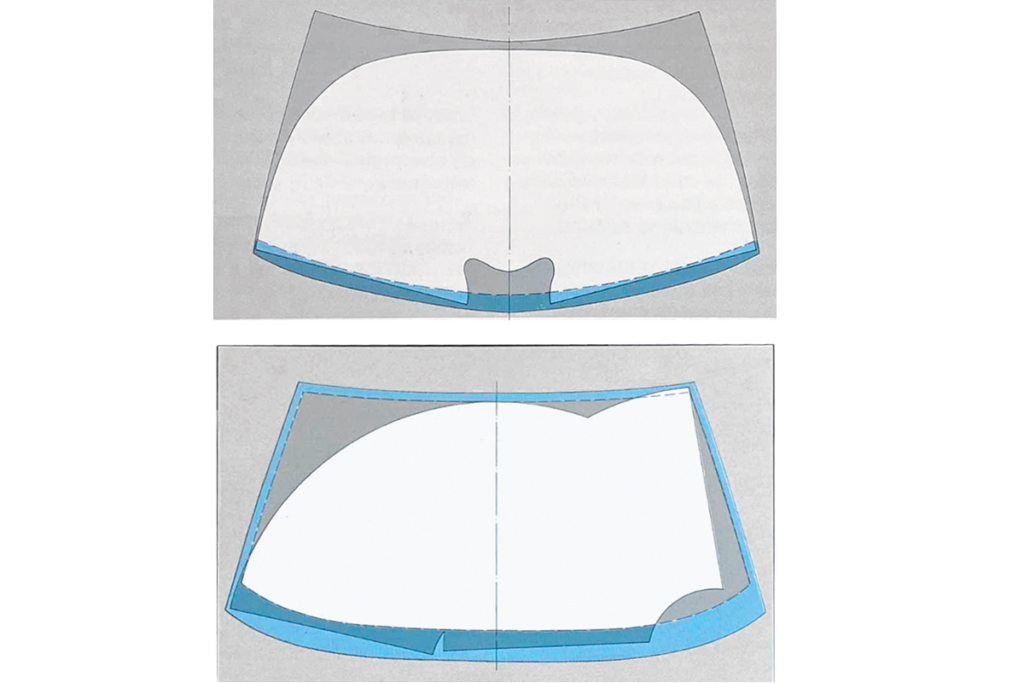
Il tergicristallo di Mercedes raggiunge gli angoli superiori e offre un’area di pulizia del parabrezza da record per l’industria automobilistica. BMW insiste sul fatto che l’angolo superiore sinistro è più importante per la visibilità ai semafori.
La BMW M5 rimane una testimonianza di questa feroce competizione, incarnando l’incessante ricerca dell’eccellenza e dell’innovazione automobilistica. Mentre questi rivali si spingevano l’uno verso l’altro, hanno lasciato un’eredità di abilità ingegneristica e di prestazioni che continua a ispirare il mondo dell’automobile.
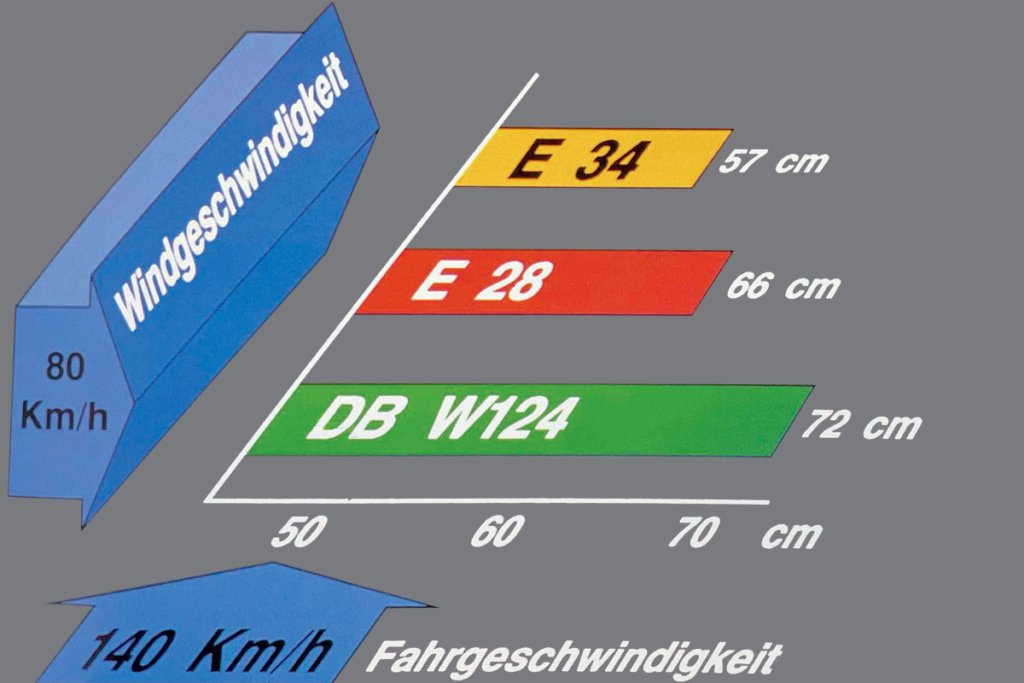
Un altro motivo per sottolineare la superiorità rispetto alla Mercedes: in presenza di vento laterale, la E34 deriva meno della W124.
Quando la Mercedes introdusse la W124, la BMW rispose prontamente con la E34, preannunciando il suo capolavoro, la M5. La controparte di Stoccarda, la 500 E, segnò l’inizio di un’affascinante rivalità tra due super berline nettamente diverse, entrambe accomunate da un’origine sorprendente: ogni modello iniziò la sua vita su un telaio di camion.
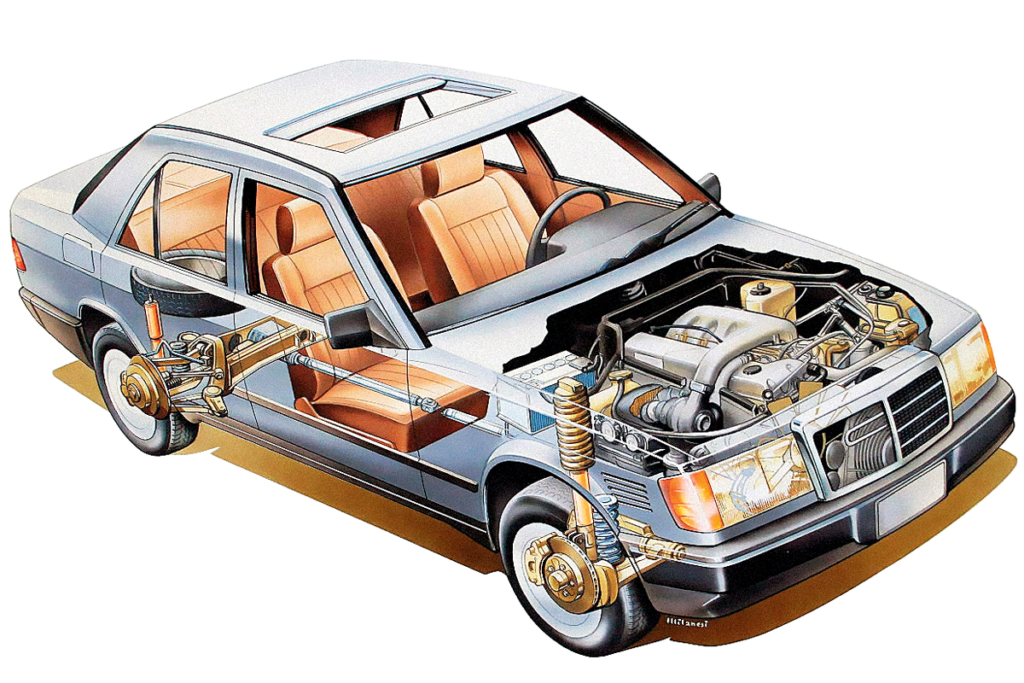
Il principale gioiello tecnico del telaio della W124 è la sospensione posteriore multilink, apparsa poco prima sulle berline più piccole W201 e successivamente installata su quasi tutte le autovetture Mercedes. È stato copiato da molti altri produttori. Con alcune modifiche, questo schema di base a cinque maglie viene utilizzato ancora oggi.
Gli anni ’80 videro la BMW impegnata a superare la Mercedes. Stoccarda era formidabile e costringeva Monaco a raddoppiare gli sforzi solo per tenere il passo. Per superare la Mercedes, la BMW aveva bisogno di qualcosa di straordinario. Lo fece nel 1986 con il debutto della E32 “Seven” e un anno dopo stupì ulteriormente il mondo automobilistico con la BMW 750i con motore V12. La sfida era replicare questo successo con la “Cinque”.
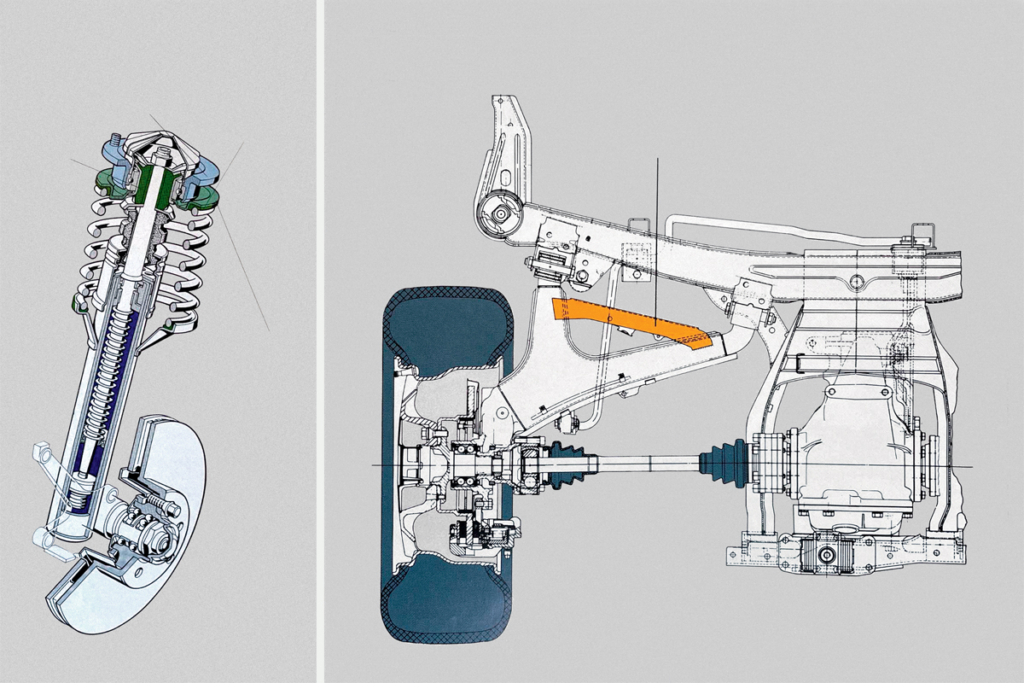
Per tutte le versioni E34 superiori alla BMW 525i e 524td, erano previsti montanti McPherson con supporti separati per molle e ammortizzatori. Nella parte posteriore, i bracci obliqui sono stati rinforzati con bretelle. Questa è stata l’ultima “Five” con un assale posteriore di vecchia concezione. In opzione, tranne che per la M5, veniva offerta una sospensione Sport più rigida.
Lanciate nel 1988, le berline E34 erano focalizzate su un unico obiettivo: l’eccezionale W124. Quattro anni dopo il suo debutto, la Mercedes incarnava ancora lo zenit dell’ingegneria automobilistica.
Durante il nostro test retrospettivo, ho trascorso diversi giorni con un catalogo unico per i concessionari, il BMW Praxis, progettato per formare il personale di vendita sulla nuova “Cinque”. Questa bibbia di 240 pagine della E34 copre ogni minimo dettaglio e decisione progettuale del veicolo. È ricco di approfondimenti unici e ha un prezzo di 30.000 rubli, a testimonianza del suo valore. In particolare, la W124 è citata in quasi tutte le pagine, sottolineando un’apparente ossessione.
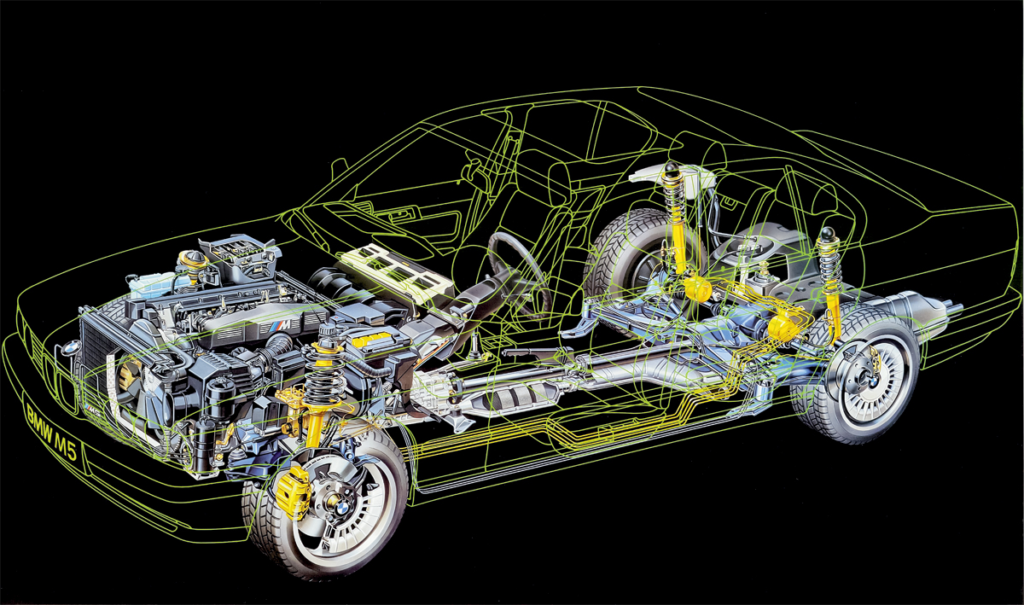
Le complesse sospensioni multi-link di BMW comparvero solo nel 1989 sulla E31 coupé e poi sulla E38 “Seven” e sulla E39 “Five”. Ma la M5 E34, ancor prima dell’uscita della Mercedes 500 E, era equipaggiata di serie con ammortizzatori posteriori dotati di un meccanismo idraulico di autolivellamento per mantenere costanti gli angoli di campanatura e il gioco delle ruote.
La battaglia è iniziata con le strategie di marketing, con BMW che ha effettuato un confronto dettagliato delle quote di mercato nelle varie professioni. Il marchio “Elica” aveva una maggiore risonanza tra i quadri intermedi, mentre la “Stella” trovava il favore dei dirigenti di alto livello e dei liberi professionisti. BMW ha anche vantato prodezze ingegneristiche, dichiarando un significativo miglioramento aerodinamico rispetto al suo predecessore e raggiungendo un coefficiente di resistenza aerodinamica di 0,30, pur mantenendo l’iconica inclinazione negativa delle narici. L’azienda suggeriva sottilmente che questi risultati avrebbero potuto essere ancora migliori, accennando al fatto che i concorrenti, come la Mercedes, utilizzavano pneumatici più stretti per ottenere valori ottimali.
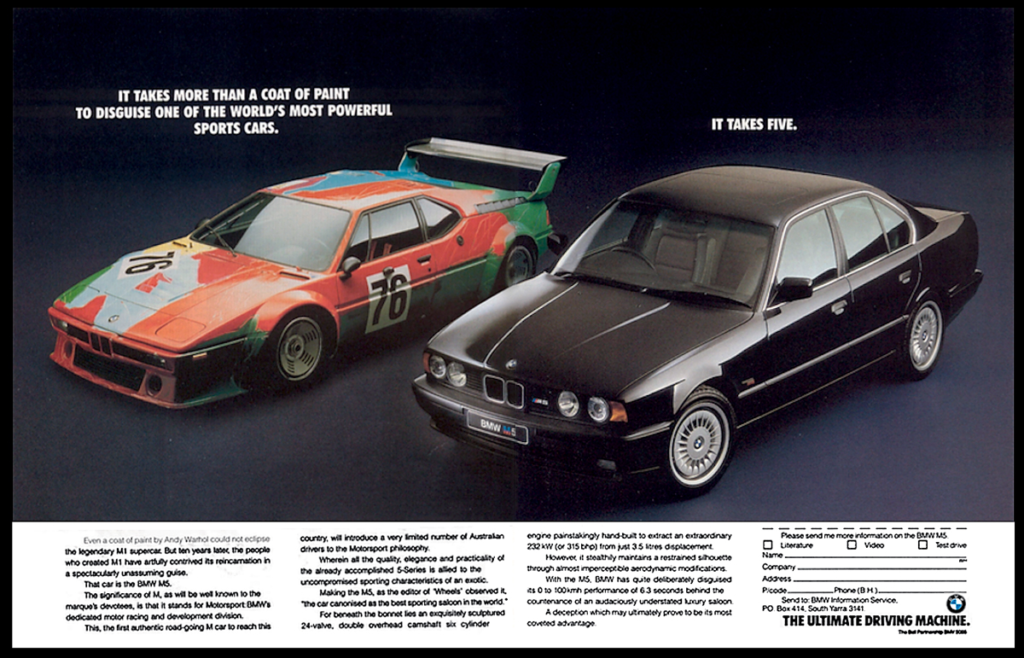
La stirpe dei motori M5 viene tradizionalmente fatta risalire al “sei” M88 della BMW M1, anche se il vero capostipite fu la BMW 3.0 CSL. La versione M88/3 senza carter secco era destinata alla E28 M5 in Europa, mentre il primo motore etichettato S38B35 era la versione “catalitica” per l’America. I motori S38 della E34 ereditarono un blocco di ferro e una testa DOHC a 24 valvole.
BMW ha eguagliato l’innovativo sistema di tergicristalli di Mercedes, che ha pulito l’86% del vetro, estendendo il raggio d’azione dei tergicristalli e aggiungendo un meccanismo alla base per migliorare l’aderenza delle lame alle basse velocità. Hanno anche introdotto una funzione unica in cui tirando e tenendo premuta la maniglia della porta si attiva il riscaldamento della serratura, un’aggiunta intelligente per i climi più freddi.
Dai poggiatesta posteriori ripiegabili azionati da servocomandi invece che da molle, a un sistema di controllo della trazione più sofisticato, in grado di gestire sia la perdita di trazione sia la decelerazione improvvisa, BMW sembrava determinata non solo a competere, ma anche a essere leader nell’innovazione. Le nuove caratteristiche di ciascun modello miravano a superare quelle dell’altro, con BMW che perfezionava continuamente i suoi progetti per rispondere ai progressi di Mercedes.
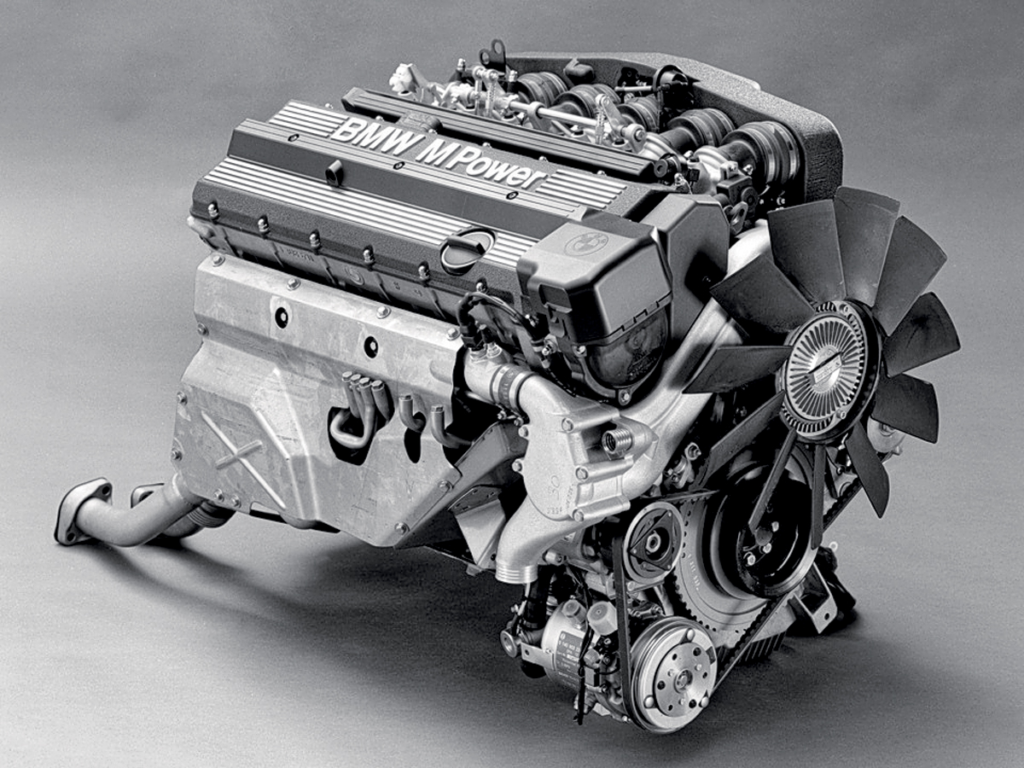
Il motore S38B36 (315 CV) della M5 pre-facelift aveva in realtà una cilindrata di 3535 cc, ma fu designato 3.6 per differenziarlo dal motore precedente con una cilindrata di 3453 cc sulla M5 E28.
Inoltre, il catalogo BMW forniva una motivazione per le caratteristiche di maneggevolezza della M5, indicando una messa a punto deliberata per un sottosterzo da neutro a leggero, che poteva passare a un sovrasterzo quando si accelerava, forse un cenno alla natura “derapante” della “124”.
Questa rivalità non solo spinse i confini della tecnologia automobilistica, ma evidenziò anche l’intenso spirito competitivo tra i due marchi. Sebbene la E34 abbia brevemente superato la W124, non è riuscita a replicare l’impatto rivoluzionario del dodici cilindri della E32. Nonostante condividesse la piattaforma con la “Seven”, la “Five” era sempre all’inseguimento, adottando innovazioni come le carrozzerie station wagon, la trazione integrale e caratteristiche di sicurezza migliorate che riprendevano quelle sperimentate dalla Mercedes. La BMW M5 rimane un monumento a questa feroce rivalità, a dimostrazione di come la competizione spinga l’innovazione e l’eccellenza nell’industria automobilistica.
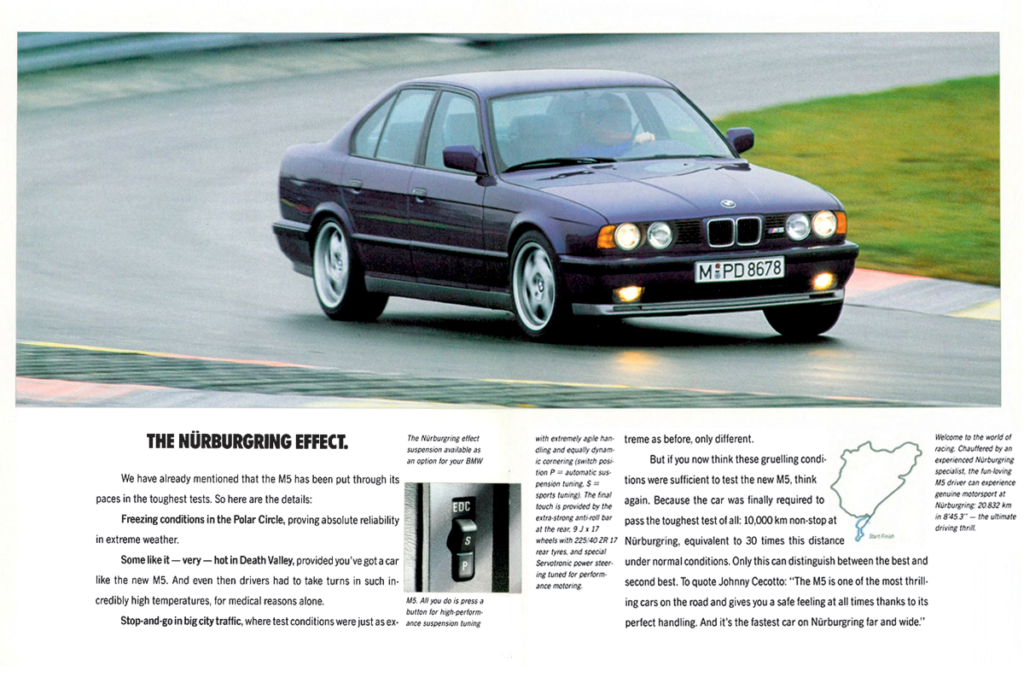
L’effetto Nürburgring significa che durante i test, la BMW M5 berlina con ammortizzatori adattivi EDC ha completato un percorso di diecimila chilometri non-stop sul “North Loop” del Nürburgring e ha registrato il miglior tempo di 8’45.3″ (su un tracciato di 20.832 km).
Tre anni fa, in occasione del 30° anniversario della Mercedes 500 E, il servizio stampa Porsche ha pubblicato un’intervista con Michael Hölscher, il responsabile del progetto Typ 2758. Le successive apparizioni di Hölscher nei podcast hanno fatto ulteriore luce sulle sfumature di sviluppo di questo modello iconico. Ha chiarito che il layout della berlina, la scelta del motore e della trasmissione dalla 500 SL roadster, il design e l’aerodinamica sono stati determinati esclusivamente da Mercedes. Porsche fu incaricata principalmente di integrare questi componenti nel telaio della W124, che inizialmente non era stato progettato per ospitare motori V8.
Questa collaborazione ha richiesto notevoli adattamenti, tra cui lo spostamento dei condotti di aspirazione, la deviazione dei tubi dei freni e del carburante, le modifiche al tunnel centrale, l’allargamento della pista e la realizzazione di un programma completo di test di guida. È interessante notare che Mercedes ha scelto di non includere la messa a punto del Nürburgring in questo progetto, sottolineando uno scenario in cui le specifiche del cliente erano fondamentali per Porsche.
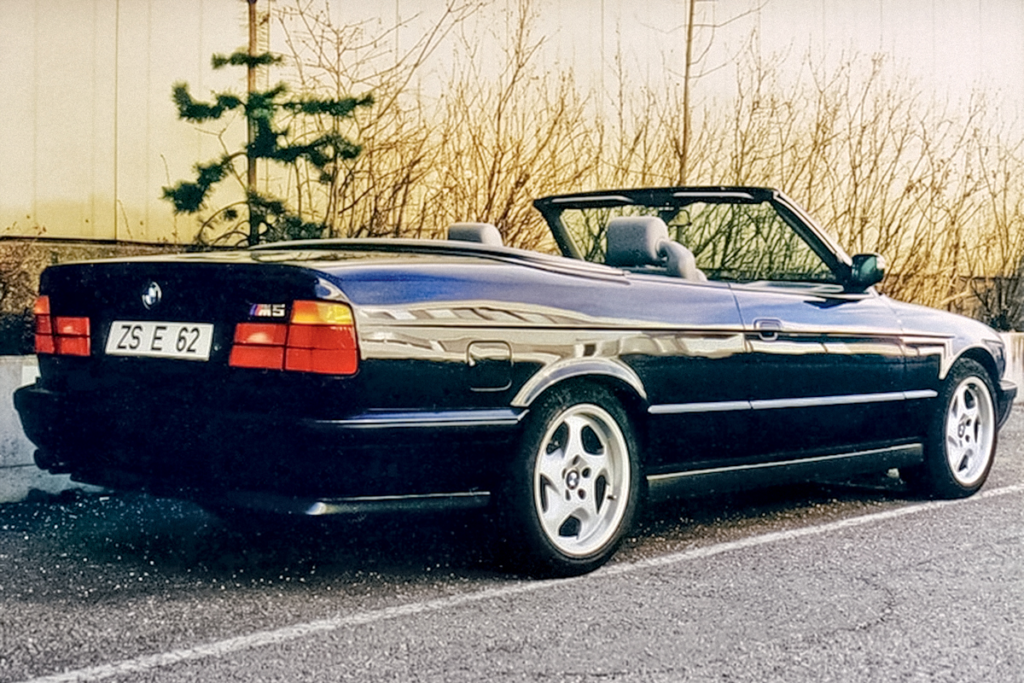
Al Salone dell’automobile di Ginevra del 1989 avrebbe dovuto essere presentata una M5 cabriolet con carrozzeria E35, ma una settimana prima della prima, BMW temeva che avrebbe danneggiato la domanda di M3 aperta e cancellò il progetto. Il prototipo è stato presentato solo nel 2009.
Una notevole innovazione di Zuffenhausen fu lo sviluppo del sistema di gestione elettronica del motore. In effetti, la 500 E è stata pionieristica sia per Mercedes che per Porsche, in quanto è stata la prima vettura dotata di un sistema CAN-bus.
Hölscher ha anche sfatato il mito secondo cui la 500 E non poteva essere montata sulla linea di montaggio di Sindelfingen a causa dei suoi parafanghi anteriori troppo larghi, che si diceva fossero stati progettati da Porsche. Ha spiegato che questi parafanghi sono stati in realtà concepiti dai progettisti Mercedes, che erano ben consapevoli dei vincoli della catena di montaggio. La decisione di non adattare le attrezzature dello stabilimento di Sindelfingen per i parafanghi più larghi, ma di esternalizzare alcune fasi di produzione alla Porsche, è stata una strategia efficace dal punto di vista dei costi. Ciò solleva una possibilità intrigante: forse Mercedes intendeva che questa berlina speciale fosse assemblata in un luogo unico, lontano dalle linee di produzione standard, proprio come l’approccio di BMW.
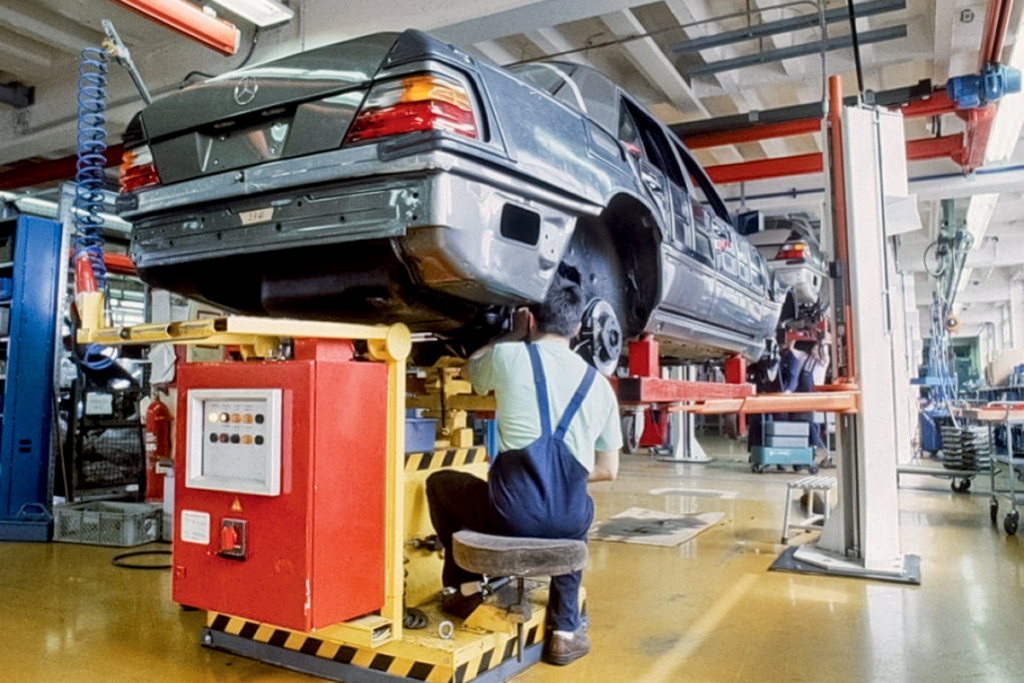
Nello stabilimento Porsche, le auto Mercedes venivano assemblate senza nastro trasportatore, su ascensori e carrelli. Il codice VIN di queste auto dovrebbe includere i numeri 124.036.
Alla fine, la Mercedes 500 E è stata assemblata in tre sedi. I pannelli stampati della carrozzeria sono stati trasportati da Sindelfingen a Zuffenhausen, dove Porsche ha aggiunto parti e le ha assemblate in telai nell’edificio Reutter Bau, che prende il nome dalla storica Reutter Karosseriewerk, una carrozzeria che ha lavorato con Ferdinand Porsche dal 1906 e ha svolto un ruolo importante nelle prime carrozzerie delle auto Porsche. Dopo l’assemblaggio iniziale, i telai sono tornati a Sindelfinden per la verniciatura e quindi a Zuffenhausen per l’assemblaggio finale nello stabilimento Rössle Bau, già sede della produzione della Porsche 959.
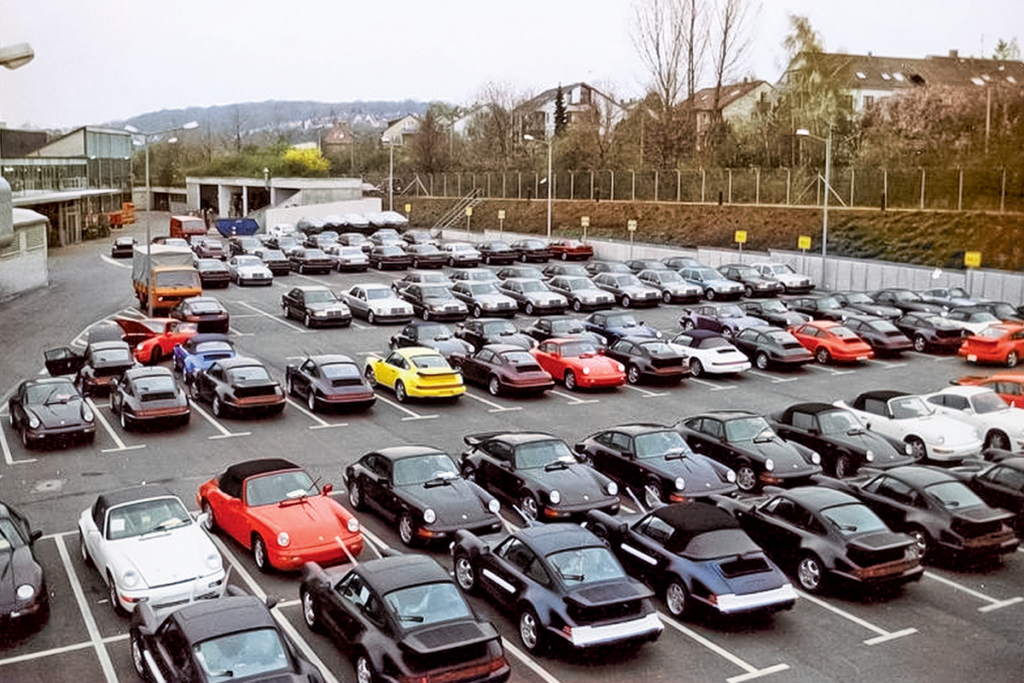
I primi anni ’90, i prodotti finiti nello stabilimento di Zuffenhausen: diverse Porsche 964 e quaranta Mercedes sullo sfondo.
La complessità logistica di questo processo era notevole: ci volevano 18 giorni per produrre ogni veicolo. Nonostante ciò, il processo di produzione si è dimostrato più efficiente di quello della BMW M5. Inizialmente la Mercedes aveva previsto che la Porsche producesse dieci vetture al giorno, ma a causa della domanda incontenibile i ritmi di produzione raddoppiarono.
Con un prezzo superiore a quello della Classe S, pari a 135.000 marchi tedeschi, e con un picco di domanda e di produzione nel 1992, la 500 E si trasformò presto in E 500, nell’ambito del lifting del 1993 che trasformò l’intera serie “124” in Classe E. Sebbene l’ingegneria sia rimasta invariata, l’aumento del prezzo a 146.000 marchi ha portato a un calo delle vendite, culminato con la cessazione della produzione nel 1995. Tuttavia, la meno potente 400 E (poi E 420) continuò fino al 1996 con numeri doppi.
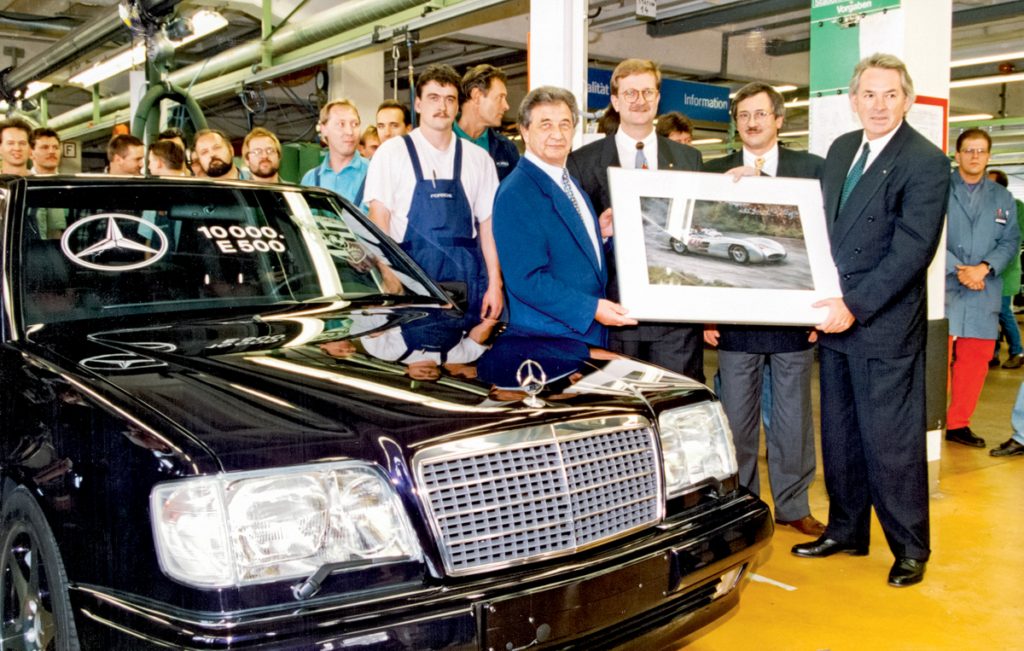
La 10.000esima “Cinquecento” Mercedes è stata prodotta nell’ottobre 1994, già con l’indice E 500 rielaborato. Successivamente sono state assemblate altre 479 unità. L’auto fu regalata a Hans Herrmann, che corse per la Mercedes in Formula 1 negli anni ’50 e che nel 1970 vinse la prima Le Mans per la Porsche.
Questo progetto non solo ha stabilizzato la situazione finanziaria di Porsche, ma ha anche posto le basi per progetti futuri come l’Audi RS2, dove Porsche ha esercitato una maggiore influenza ingegneristica. La leadership di Michael Hölscher si è estesa oltre questo progetto, contribuendo allo sviluppo della Carrera GT e della Porsche 918 Spyder prima del suo ritiro nel 2016.
Mercedes, dopo aver riconosciuto la natura lucrativa dei modelli ad alte prestazioni attraverso il progetto 500 E, decise nel 1993 di mantenere esclusivo questo “caviale” del settore automobilistico, portando all’uscita della prima Mercedes C 36 AMG e ponendo le basi per le future innovazioni ad alte prestazioni ben note oggi.
Foto: BMW | Mercedes-Benz | Sergey Znaemsky
Questa è una traduzione. Potete leggere l’articolo originale qui: Эхо друг друга: как создавались BMW M5 и Mercedes-Benz 500 E из нашего ретротеста

Pubblicato Giugno 20, 2024 • 14m da leggere

